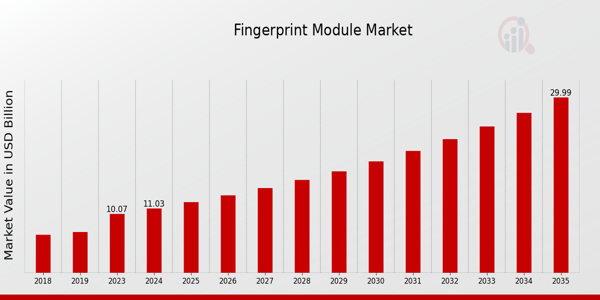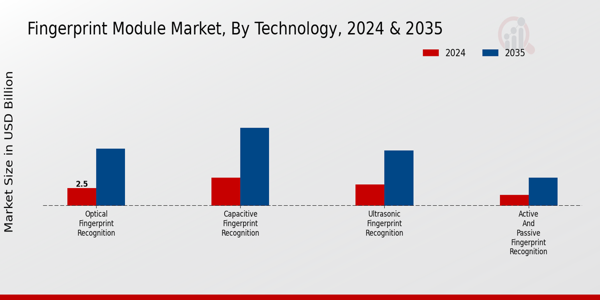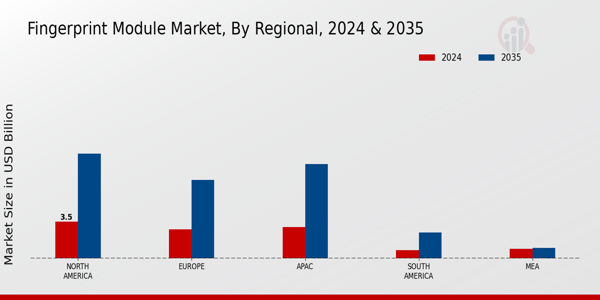Fingerprint Module Market Overview
Fingerprint Module Market Size was estimated at 10.07 (USD Billion) in 2023.
The Fingerprint Module Market Industry is expected to grow from 11.03(USD Billion) in 2024 to 30.0 (USD Billion) by 2035. The Fingerprint Module Market CAGR (growth rate) is expected to be around 9.52% during the forecast period (2025 - 2035).
Key Fingerprint Module Market Trends Highlighted
There are ample opportunities to be explored in the fingerprint module market. The advancement of technology presents a pathway for innovation, particularly in improving the accuracy and speed of fingerprint recognition systems. Companies can capitalize on emerging markets where biometric solutions are still gaining traction. There is also potential for collaboration between tech firms and security providers, leading to the development of enhanced biometric systems. Furthermore, the rise of the Internet of Things (IoT) is creating opportunities for integrating fingerprint modules in various smart devices, making them more secure and user-friendly.Recent trends indicate an increasing focus on miniaturization and the development of ultra-thin fingerprint sensors. The use of flexible and durable materials is also gaining prominence, allowing integration into diverse products. Additionally, advancements in artificial intelligence are enhancing fingerprint recognition capabilities, making systems more efficient. The market is witnessing a shift toward contactless fingerprint solutions, which have become particularly relevant in the context of health and hygiene concerns. As companies continue to invest in research and development, the fingerprint module market is set for continued transformation and innovation.

Source: Primary Research, Secondary Research, MRFR Database and Analyst Review
Fingerprint Module Market Drivers
Rising Demand for Biometric Security Solutions
The Global Fingerprint Module Market Industry is experiencing significant growth due to the increasing demand for biometric security solutions across various sectors, including banking, healthcare, and consumer electronics. With the rise in cyber threats and the need for enhanced security measures, organizations are turning to biometric technologies as a reliable means of authentication. Fingerprint modules provide an advanced level of security compared to traditional methods, fostering a growing preference among consumers and businesses alike.The adoption of fingerprint technology in smartphones, tablets, and other personal devices has revolutionized the way individuals interact with technology. This shift is driving manufacturers to innovate and enhance their product offerings, leading to a competitive market landscape. Furthermore, governments and regulatory bodies are actively promoting the adoption of biometric systems to bolster security measures, especially in sensitive sectors such as national defense and public safety.The combination of technological advancements and the heightened demand for secure access solutions is expected to propel the Global Fingerprint Module Market further, ensuring its relevance and growth in the coming years.
Increased Adoption of Smartphones and Wearable Devices
The proliferation of smartphones and wearable devices equipped with fingerprint recognition technology is a substantial driver for the Global Fingerprint Module Market Industry. As consumers increasingly prioritize security features in their devices, manufacturers are integrating fingerprint sensors to enhance user experience. This trend is further supported by the advancements in sensor technologies and miniaturization, allowing for seamless integration into various consumer electronics.The growing acceptance of these devices among consumers is leading to a higher demand for fingerprint modules that support secure transactions, information access, and identity verification.
Government Initiatives and Regulatory Frameworks
Government initiatives and regulatory frameworks promoting the use of biometric technologies significantly impact the Global Fingerprint Module Market Industry. As governments aim to improve security measures in public services and infrastructure, funding and support for biometric solutions have become more prevalent. These initiatives encourage the adoption of fingerprint systems in various sectors, including immigration control, law enforcement, and public safety, driving market growth.Additionally, regulatory mandates regarding data privacy and security are motivating organizations to prioritize biometric solutions, further fueling demand within the market.
Fingerprint Module Market Segment Insights:
Fingerprint Module Market Technology Insights
The Global Fingerprint Module Market is rapidly evolving, driven by advancements in Technology. The overall market is poised for significant growth, with a notable valuation of 11.03 USD Billion in 2024, expected to increase to 30.0 USD Billion by 2035. This upward trend highlights the increasing reliance on fingerprint recognition systems across various industries, emphasizing the critical role of these technologies in enhancing security and user authentication. A detailed examination of the Global Fingerprint Module Market segmentation reveals the importance of distinct fingerprint recognition technologies. Optical Fingerprint Recognition stands out in the market, as evidenced by its valuation of 2.5 USD Billion in 2024, which is projected to rise to 8.11 USD Billion by 2035. This technology harnesses light reflection to capture fingerprint images, making it integral for devices requiring high-scanner performance while maintaining quality and speed. It serves a dominant position in various consumer electronics, including smartphones and laptops, contributing to its significant market presence.
Capacitive Fingerprint Recognition follows closely, demonstrating robust valuation metrics of 4.0 USD Billion in 2024 and anticipated growth to 11.06 USD Billion in 2035. This technology employs capacitive sensors to identify fingerprints, providing a high level of security and responsiveness. Its increasing adoption in smartphones and secure access systems is a testament to its effectiveness, further driving its expansion in the Global Fingerprint Module Market.Ultrasonic Fingerprint Recognition also plays a pivotal role, with an initial valuation of 3.0 USD Billion in 2024 and a projected rise to 7.87 USD Billion in 2035. Ultrasonic technology uses sound waves to capture detailed fingerprint information, enabling improved accuracy and the ability to operate through various materials. This capability opens opportunities for innovative applications and is particularly significant in the context of three-dimensional imaging, enhancing security in advanced devices.
On the other hand, Active and Passive Fingerprint Recognition encompasses a smaller portion of the market, noted at 1.53 USD Billion in 2024 and expected to reach 3.96 USD Billion by 2035. The distinction between active, which involves deliberate interaction, and passive recognition, occurring without user engagement, enriches the utility of fingerprint systems across different applications. While it represents the least dominant segment in terms of market revenue, its relevance in specialized applications keeps it crucial for sectors that require varied authentication methods.
The diverse range of technologies within the Global Fingerprint Module Market is driven by increasing demand for secure and efficient identification solutions. The growth in biometric technology deployment, alongside innovations in fingerprint sensing methods, presents opportunities for manufacturers and developers. The continuous emergence of new applications across various sectors such as banking, healthcare, and consumer electronics underscores the potential for expansion within this evolving market. As the landscape of fingerprint technology continues to evolve, the importance of segmentation, including Optical, Capacitive, Ultrasonic, and Active and Passive Fingerprint Recognition, remains a focal point for industry stakeholders aiming to capitalize on market growth trends and consumer analytics.

Source: Primary Research, Secondary Research, MRFR Database and Analyst Review
Fingerprint Module Market Application Insights
The Global Fingerprint Module Market revenue 11.03 USD Billion in 2024, showcasing significant growth potential across various applications. A notable driver for this expansion is the increasing adoption of fingerprint technology in Mobile Devices, where user authentication is essential for security and convenience. In addition, Access Control Systems are becoming more prevalent in both residential and commercial spaces, emphasizing the need for robust security measures. Automated Teller Machines also rely heavily on fingerprint modules for secure transactions, enhancing consumer trust.Point of Sale Terminals are rapidly incorporating fingerprint recognition to streamline payment processes and reduce fraud, capturing a major share of the market. This diverse application landscape not only represents a wide range of use cases but also indicates a growing trend toward biometric authentication in everyday transactions. The Global Fingerprint Module Market data reflects these dynamics as the industry prepares to evolve significantly over the next decade, with promising growth across all segments. The market statistics suggest that the demand for advanced fingerprint solutions will continue to rise, driven by the need for enhanced security features and user-friendly interfaces.
Fingerprint Module Market Use Insights
The Global Fingerprint Module Market is experiencing robust growth across various end-use applications, propelled by the rising demand for enhanced security solutions. By 2024, the market is set to reach a valuation of 11.03 billion USD, reflecting the increasing integration of biometric technologies in daily life. Among the end uses, consumer electronics plays a pivotal role, where fingerprint modules are embedded in smartphones and other devices for user authentication, significantly impacting user experience. The banking and financial services sector also substantially contributes to the market due to the need for secure transactions and identity verification, directly correlating with rising concerns about fraud.Additionally, the government and defense sectors leverage fingerprint technology for secure access to sensitive information and facilities, ensuring national security. The healthcare industry is embracing fingerprint modules for patient identification and data security, affirming its significance in protecting sensitive health data. Overall, the diverse applications of fingerprint modules across these sectors underscore a notable market growth trajectory driven by advancing technology and increasing security needs.
Fingerprint Module Market Component Insights
The Global Fingerprint Module Market for the Component segment is poised for robust growth as it reflects increasing adoption across various sectors. By 2024, the complete market valued at 11.03 USD Billion, illustrating significant potential. The segment's composition includes critical elements like Fingerprint Sensors, which are fundamental for capturing biometric data, making them a cornerstone for ensuring security in devices. Fingerprint Module Software is vital for processing and analyzing the captured data, thereby enhancing the sector's efficiency.Interface Controllers serve as crucial links between sensors and processing units, streamlining the communication necessary for real-time biometric authentication. Additionally, Processing Units play a significant role in managing and executing data operations, further establishing their importance in today's technology-driven environment. This diverse composition emphasizes the interconnectivity of elements within the Global Fingerprint Module Market, contributing to a cohesive system that meets the growing demand for secure authentication solutions.The demand for these components is driven by advancements in technology, increased security concerns, and a broader acceptance of biometric systems in various applications. Furthermore, trends such as mobile and digital transformation fuel this market's growing dynamics.
Fingerprint Module Market Regional Insights
The Global Fingerprint Module Market is witnessing substantial growth across various regions, with key areas such as North America, Europe, and APAC leading the charge. North America holds a majority stake in the market, valued at 3.5 USD Billion in 2024 and projected to reach 10.0 USD Billion by 2035, making it a significant player due to high technology adoption. Europe follows closely with a valuation of 2.8 USD Billion in 2024, expected to expand to 7.5 USD Billion in 2035, driven by increasing demand for security and biometric solutions. In the APAC region, the market is valued at 3.0 USD Billion in 2024 and is anticipated to grow to 9.0 USD Billion by 2035, thanks to a rapidly growing population and expanding consumer electronics market.South America and MEA account for smaller portions of the market, valued at 0.8 USD Billion and 0.93 USD Billion in 2024, respectively, but are projected to grow to 2.5 USD Billion and 1.0 USD Billion by 2035, as they increasingly recognize the importance of biometric authentication in enhancing security measures. Together, these regional insights demonstrate the varied landscape and growth potential of the Global Fingerprint Module Market, with North America and APAC poised to dominate the landscape due to their strong technological foundations and investment in security advancements.

Source: Primary Research, Secondary Research, MRFR Database and Analyst Review
Fingerprint Module Market Key Players and Competitive Insights:
The Global Fingerprint Module Market is experiencing significant growth due to increasing demand for biometric solutions across various sectors such as consumer electronics, security, and automotive industries. This market is characterized by intense competition, with numerous players striving to enhance their product offerings. Innovations in technology, such as the integration of artificial intelligence and machine learning in fingerprint recognition systems, are driving the development of more advanced, secure, and accurate fingerprint modules. The rising concerns regarding security breaches and identity theft are prompting greater adoption of biometric solutions, contributing to competitive dynamics within the market. Major players are focusing on strategic partnerships, collaborations, and acquisitions to strengthen their positions and expand their technological capabilities to cater to the diverse needs of end-users.
Holtek Semiconductor has established a strong foothold in the Global Fingerprint Module Market, known for its innovative solutions and the quality of its fingerprint modules. The company leverages its expertise in semiconductor design to develop advanced fingerprint recognition technology that is highly reliable and efficient. Holtek focus on research and development has enabled it to introduce unique features in its fingerprint modules, such as low power consumption and high accuracy, making products appealing to manufacturers of consumer electronics and security devices. Their commitment to delivering robust performance while maintaining cost efficiency has allowed them to gain a competitive edge, effectively positioning them as a leader in the biometric sector.SecuGen is another key player in the Global Fingerprint Module Market, recognized for its high-performance fingerprint recognition technology. The company specializes in delivering optical and capacitive fingerprint readers, emphasizing accuracy, durability, and ease of integration.
SecuGen stands out due to its strong commitment to quality and reliability, with a proven track record of providing solutions that meet various industry requirements. The company's innovative designs cater to a wide range of applications, from access control to mobile devices, allowing it to maintain a diverse customer base. With a focus on enhancing user experience through continuous technological advancements and exceptional customer service, SecuGen has carved out a substantial market presence, reinforcing its role as a major contender in the fingerprint module landscape.
Key Companies in the Fingerprint Module Market Include:
- Holtek Semiconductor
- SecuGen
- Qualcomm
- Next Biometrics
- Synaptics
- Finisar
- ZKTeco
- Idemia
- Fingerprint Cards
- NEC Corporation
- MSI
- Apple
- Samsung
- Gemalto
Fingerprint Module Market Industry Developments
The Global Fingerprint Module Market is witnessing significant advancements as companies continue to innovate and expand their offerings. Recently, Holtek Semiconductor announced enhancements to its fingerprint module technology, targeting improved security applications. SecuGen has launched a new biometric scanner with advanced detection capabilities, aiming to capture more accurate authentication data. Qualcomm, known for its strong investment in biometric technologies, has made strides in integrating fingerprint recognition into its Snapdragon platform, enhancing device security. the merger and acquisition front, Fingerprint Cards has been actively pursuing potential partnerships to bolster its position in the market, while Idemia's acquisition of biometric technology firms has strengthened its market reach. Additionally, Samsung and Apple are exploring new ways to enhance their fingerprint recognition capabilities, indicating ongoing competition and innovation among the leading tech giants. The overall sentiment in the market indicates positive growth, with increasing adoption of biometric systems in various sectors contributing to a rising valuation across these companies, reflecting a robust response to consumer demands for secure and convenient authentication solutions.
Fingerprint Module Market Segmentation Insights
Fingerprint Module Market Technology Outlook
- Optical Fingerprint Recognition
- Capacitive Fingerprint Recognition
- Ultrasonic Fingerprint Recognition
- Active and Passive Fingerprint Recognition
Fingerprint Module Market Application Outlook
- Mobile Devices
- Access Control Systems
- Automated Teller Machines
- Point of Sale Terminals
Fingerprint Module Market Use Outlook
- Consumer Electronics
- Banking and Financial Services
- Government and Defense
- Healthcare
Fingerprint Module Market Component Outlook
- Fingerprint Sensor
- Fingerprint Module Software
- Interface Controllers
- Processing Units
Fingerprint Module Market Regional Outlook
- North America
- Europe
- South America
- Pacific
- Middle East and Africa
Fingerprint Module Market Scope:
| Attribute/Metric Source: |
Details |
| MARKET SIZE 2023 |
10.07(USD Billion) |
| MARKET SIZE 2024 |
11.03(USD Billion) |
| MARKET SIZE 2035 |
30.0(USD Billion) |
| COMPOUND ANNUAL GROWTH RATE (CAGR) |
9.52% (2025 - 2035) |
| REPORT COVERAGE |
Revenue Forecast, Competitive Landscape, Growth Factors, and Trends |
| BASE YEAR |
2024 |
| MARKET FORECAST PERIOD |
2025 - 2035 |
| HISTORICAL DATA |
2019 - 2024 |
| MARKET FORECAST UNITS |
USD Billion |
| KEY COMPANIES PROFILED |
Holtek Semiconductor, SecuGen, Qualcomm, Next Biometrics, Synaptics, Finisar, ZKTeco, Idemia, Fingerprint Cards, NEC Corporation, Ubisys, MSI, Apple, Samsung, Gemalto |
| SEGMENTS COVERED |
Technology, Application, End Use, Component, Regional |
| KEY MARKET OPPORTUNITIES |
Increasing demand in mobile devices, Growth in biometric security applications, Expansion in smart home technology, Rising adoption in government sectors, Integration with IoT solutions |
| KEY MARKET DYNAMICS |
Increasing security concerns, Technological advancements, Growing adoption in mobile devices, Demand in biometric authentication, Rising cybersecurity investments |
| COUNTRIES COVERED |
North America, Europe, APAC, South America, MEA |
Frequently Asked Questions (FAQ) :
The Global Fingerprint Module Market is expected to bewas valued at 11.03 USD Billion in 2024.
By 2035, the Global Fingerprint Module Market is anticipated to reach a value of 30.0 USD Billion.
The expected CAGR for the Global Fingerprint Module Market from 2025 to 2035 is 9.52%.
North America is projected to have the highest market value of 10.0 USD Billion in 2035.
The market size for Capacitive Fingerprint Recognition is valued at 4.0 USD Billion in 2024.
Key players in the market include Holtek Semiconductor, SecuGen, Qualcomm, and Fingerprint Cards, among others.
The expected market value of Optical Fingerprint Recognition in 2035 is 8.11 USD Billion.
The market value of the Global Fingerprint Module Market in the APAC region is projected to be 3.0 USD Billion in 2024.
The Active and Passive Fingerprint Recognition technology is expected to reach a market size of 3.96 USD Billion by 2035.
Challenges may include technological advancements, regulatory compliance, and competition from alternative biometric solutions.
















